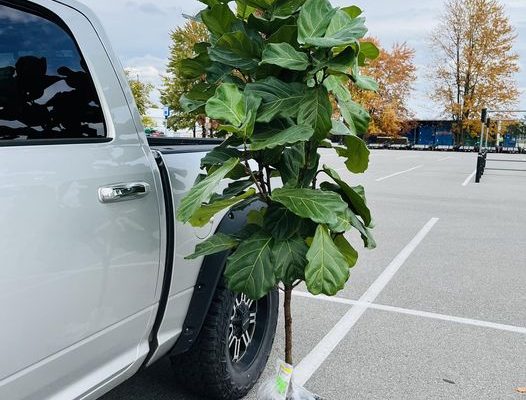Enter details on the plant, pest, or disease you have questions on.
Be as detailed as you can. INSTANT RESPONSE. Email not required!
Of course, prevention is the best medicine, so we’ll also look at proper watering methods.
Signs Of An Overwatered Fiddle Leaf Fig
Browning leaves are one of the most obvious signs of overwatering, but the affected leaf cannot be saved at this point.
Another sign is edema, which is when the leaf has taken in so much water that it forms blisters.
Those blisters will eventually burst, leaving wounds that can quickly become necrotic.
Wilting is another sign because the leaves have grown too soggy to stay upright, and some leaf curls may accompany the wilting.
Finally, you may see mold in the soil or water pooling in extreme cases if you gently press on the soil surface.
Overwatering Isn’t (Usually) The End
Even though fiddle leaf figs can get sick faster when overwatered, they can still be saved if the damage hasn’t advanced too far.
This doesn’t mean you shouldn’t worry about supplying the correct amount of water, however, as overwatering can invite fungal infections and pest problems and stress the plant.
Treating Slight Overwatering
When you accidentally overwater your fiddle leaf fig one time, it’s not the end of the world, but you should still attempt to remove any excess water.
If you see puddles on the soil surface, you can use an eyedropper or syringe to remove the puddles.
You can also take some paper towels and lay them on the soil to soak up excess liquid even if you don’t see any pooling.
Finally, you may wish to skip the next feeding if you’re using a liquid fertilizer, so the soil has more time to dry out.
Treating Severe Overwatering
Multiple overwatering can be a lot more dangerous, and by the time you see symptoms, the situation is already severe.
Thus, it’s vital to take immediate action when you suspect the plant has been severely overwatered.
Pruning And Uprooting
The first step is to remove any foliage that has been heavily damaged, such as browned leaves.
This step is important because the leaves won’t recover and will only draw vital resources from the rest of the plant during the healing process.
As a general rule, you should never remove more than ⅓ of a plant’s foliage at one time because this can shock the plant and make it more difficult to recover.
Once you’ve pruned away the damage, remove the plant from its pot and gently rinse off as much of the soil as possible.
Root Rot And Treatment
Next, you need to do the following:
- Examine the roots for any signs of root rot. These include dark brown or black roots, a foul odor, or mushiness.
- If you find rot, you will need to remove each of the rotting roots using a sharp, sterile knife.
- Be sure to resterilize between each cut to help reduce the risk of infecting healthy roots you might brush up against.
- Also, keep in mind that root rot can be caused by various strains of both bacteria and fungi.
- You can kill any remaining traces of these strains by dipping the healthy roots in a solution made from 1 part bleach and 10 parts water for 30 minutes.
- Finally, let the plant air dry for 2 to 3 days.
Repotting
After the plant has had a little time to dry and form calluses, it’s time to repot.
The old pot should not be reused, and the old soil should be discarded as it may contain traces of rot.
Instead, do the following:
- Get a new pot and add a fresh potting mix.
- Slightly dampen the soil, then gently plant your fig.
- Add just a bit of water after to help the soil settle but don’t give it a full watering until the finger test tells you it’s time.
- Also, avoid using fertilizer for 1 to 2 months, so the plant has more time to recover.
Avoiding Future Overwatering Issues
Using the proper watering method is key to ensuring your plants always get just the right amount of water.
For most plants, this means the soak-and-dry method, which uses simple observations to tell you when to water and when to stop adding water.
The finger trick is a great way to test the soil moisture without resorting to fancy or expensive tools and can be used with any watering method.
Using The Finger Trick
The finger trick gets its name because this testing method literally uses your own finger.
On the average adult hand, the distance from the tip to the first knuckle is roughly 1″ inch and is generally the exact distance between the first and second knuckles and the second knuckle to the finger’s base.
You can put your finger beside a ruler if you have tiny hands to get a more accurate distance.
Stick your finger straight down in the soil and water your fiddle leaf fig only if it’s dry 2″ inches down.
If you can’t feel the moisture due to nerve damage or other issues, you can substitute a popsicle stick or bamboo chopstick.
Just mark them, so you know how deep to poke them and let the stick sit there for 20 minutes.
When you remove it, the stick will be darker at the level any moisture is present.
Using The Soak-And-Dry Method
This method is easy to master after only one or two tries, but the hardest part is making sure you pour slowly.
The soil should immediately soak up the water if you’re pouring slow enough and if not, simply easy up a little until it does.
Pour slowly and evenly, working your way around the plant without getting the plant itself wet.
Here are two different signs to look for that will tell you it’s time to stop.
The first sign is when the soil can no longer absorb at the rate you’re pouring, which clearly indicates that it’s now saturated.
The second possible sign is when you see water beginning to seep from the drainage holes.
Stop watering when you see either of these signs, and you can rest assured that the plant has just the right amount of water every time.




